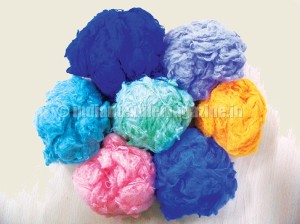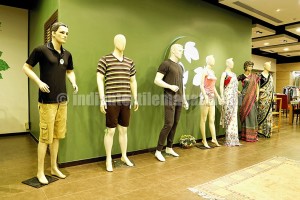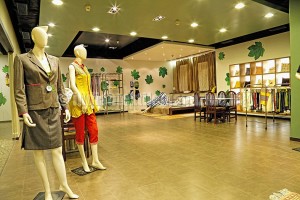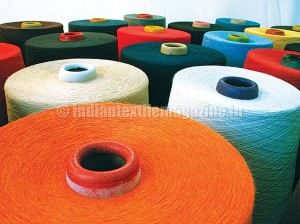Birla Cellulose’s forward integration pays
“BIG IN YOUR LIFE”. This the new TVC of the Aditya Birla Group (ABG). True to this adage, the group is expanding its presence across every segment, enhancing its engagement with its customers. Birla Cellulose, part of the Aditya Birla Group, has once again hit the spotlight with the launch of LIVA, the brand unveiled by the fibre business With this new initiative, ABG, the only company in the world to operate fully integrated manufacturing facilities extending from plantation to pulp to fibre to fashion, has now launched a new consumer-centric brand. Birla Cellulose is steadily increasing its engagement with its customers from fibre to yarn and to fabric and apparels with a view to collaborating and bringing value to consumers with this venture.
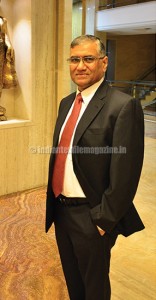
Under the leadership of Mr. Ghanshyam Das Birla, the group started foraying into viscose fibre, which dates back to pre-Independence days when the need for an alternate fibre had been shared by Mahatma Gandhi.
With razor sharp focus on each business, the Aditya Birla Group is a leading player in most segments, including copper, aluminium, cement, viscose filament yarn, carbon black, branded garments, agri business, textiles and insulators. By now, it has grown 20-fold in revenues since Mr. Kumar Mangalam Birla took over 20 years ago.
Today, Birla Cellulose has fully integrated manufacturing facilities extending from plantation to pulp in countries such as India, Canada and Sweden and fibre plants in India, Thailand, Indonesia and China. The company has recently invested Rs. 3,000 crores in its fourth plant at Vilayat. With this new production site at full capacity, the Indian VSF player will have a little over 900,000 tonnes per annum making it one of the largest manufacturers in the world. The group has an installed capacity of more than 700,000 spindles located in India, Indonesia, Thailand and the Philippines.
Birla Cellulose fibres are of 100 per cent natural origin and highly absorbent, have an especially good feel and are completely biodegradable. Birla Cellulose comprises versatile sub-brands Birla Viscose, Birla Modal, Birla Excel and Birla Sunshades. These are nature’s wonder fibres enriching every garment with softness, lustre, sheen and a very high level of comfort.
March 27 will mark yet another milestone for this conglomerate with the official launch of its brand ‘LIVA’. ABG is betting big on the LIVA program as it has tremendous potential to revolutionize the way we think about fashion in textiles.
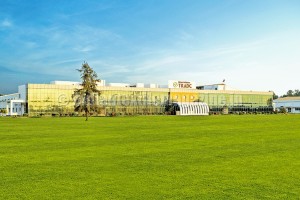
Ahead of the company’s LIVA launch, we met Mr. K.K. Maheshwari, Managing Director, Grasim Industries, & Group Director – Textiles, Aditya Birla Group, who stressed the importance of this event.
“We have been running pilot projects and working with partners across the value chain for more than two years. The result was a perfect fabric in quality that promises fluidity, elegance, superior drape and comfort – in other words, an ultimate fabric for a woman’s wardrobe”, said Mr. Maheshwari.
With its Liva brand, the company has been collaborating with major fashion brands around the world and leading brands in India like Pantaloons, Van Heusen, Allen Solly, Lifestyle, Global Desi, Chemistry and F109. It has come out with seasonal collections portraying trends for the season, leveraging the unique attributes of LIVA.
LIVA is a new age fabric using natural fibres of the Aditya Birla Group which has been innovatively manufactured by the LIVA Accredited Partner Forum (LAPF) members. It gives a beautiful flow to the garments and enhances ease of movement. Consumers have also spoken about it, and we quote “It’s is so comfortable that when you move, it moves with you”.
The fibre and textile major will also be responsible in initiating LAPF which is a unique body of value chain members who offer LIVA fabrics of high quality and innovative designs. The Accredited Forum has a certification mechanism with support on marketing, vendor management, design innovation, product perfection and sustainability. The Forum members have vastly improved their product quality, marketing services and delivery mechanism, which has been appreciated by leading brands that procure from them.
As part of its marketing strategy, the first phase of launch would focus more on women’s fashion. The products are ideally suited for ladies kurti, gowns, skirts, leggings, palazzo’s, western wear and also for intimate apparels. The company also shared that LIVA has been found enriching men’s fashion and home textile products during their research.
LIVA is profitably blended with polyester or wool, and the resulting fabric has wide applications in men’s trouser & suitings, in addition to women wear and home textiles.
With this launch, the company is extending its reach on a pan-India basis to create greater awareness and product availability. In SS15, LIVA-tagged garments will be available at 1,625 stores spread across 54 cities in India. Visual Merchandise to enhance the consumer experience has been focussed in more than 500 stores. With the fragmented retail in India, the company has joined hands with TRRAIN to educate retail staff on finer nuances of consumer experience.
Non-wovens contribute to about eight per cent of the company’s portfolio, but is expected to grow in the years to come. The biggest advantage with viscose fibre is that it is completely bio-degradable and scores on purity and absorption. Disposable wipes is the main application for viscose in nonwoven, besides medical and hygiene segments The global industry is estimated to be around $37 billion, and India’s contribution is miniscule. But things are changing now, with the advent of global multinational brands and private labels from leading retail chains trying to spread awareness. The market for wipes is now expanding fast in India, especially baby wipes that has gained traction in conjunction with baby diapers.
Global viscose market
In an industry dominated by cotton and oil-based synthetic fibre and man-made cellulose fibres, MMCF commands a small five per cent in terms of global consumption. The total textile fibre consumption has been growing at a steady pace of five per cent from 2009 to 2013. The rate of growth, going forward, is expected to remain around this level. Against this, world demand for VSF has grown at 12 per cent CAGR (CY 09-CY 13), primarily driven by the VSF industry in China.
Despite good growth, the business environment continues to remain challenging as all the leading VSF manufacturers have actively pursued capacity expansion. This has led to a large overcapacity and pressure on realisations.
The capacity addition in China has been much faster than the rest of the world. The availability of dissolving grade pulp, which was a constraint until last year, has become surplus in the current year. With a large surplus capacity, Chinese players are aggressively exporting, leading to a decline in global prices. The demand-supply imbalance and liquidity crunch in China impacted VSF prices in global markets.
In the long term, with limitations for cotton production growth due to competition with other cash crops, growing population, rising prosperity and increasing consumer awareness about the benefits of cellulosic fibre, MMCF is well positioned to achieve a larger share of the global fibre pie.
Leading innovation in the viscose industry, the business has invested in R&D across the entire chain of production. The Grasim Forest Research Institute for plantation research, Pulp Research Institute at Dominova, Sweden, for pulp research, Birla Research Institute, the Aditya Birla Science and Technology Centre (ABSTC) for fibre research, a pilot plant for fibre innovation and the Textile Research and Development Centre (TRADC) for fibre to fashion have been set up with an aggregate investment of over Rs. 100 crores.
Birla Cellulose leadership in creating awareness and best practices in sustainability has progressed with leading brands. Viscose is uniquely placed amongst the category of fibres – it is a man-made fibre and yet is natural. It brings benefits of both the worlds, being made from a natural and renewable resource like wood pulp, coupled with the engineered precision of man-made fibres.
It is one of the most sustainable in terms of raw material, life cycle assessments (LCA) and eco-friendliness of the product. The key raw material, wood pulp, is sourced through a responsible wood sourcing policy which takes care of high conservation forest, bio-diversity and more is planted than cut. The plantations in India save land 6-7 times and saves water by 3-4 times in comparison to cotton.
Studies on LCA of viscose from the cradle to the factory gate have been conducted through international agencies across various products and plants. The findings show viscose in a better light compared to most other fibres in sustainability credentials. The fibre, being eco-friendly and bio-degradable, has the highly acclaimed Oeko-Tex 100 Certificate which states it as being safe on a baby skin. As a business, steps are being taken to support the value chain in creating a sustainable process and also educating them on sustainability and traceability programs which are led by global brands. With this awareness creation and grassroot level collaboration the good benefits of viscose are enjoyed by consumers.
360° solution
Birla cellulose’s endeavour has been to focus on increasing consumption of viscose apparel by joining hands with value chain partners – the spinners, weavers, knitters and the garment maker, and designer community towards a profitable growth.
Mr. Maheshwari said: “As a world leader in the man-made cellulose fibre business, we at Birla Cellulose have collaborated with the textile community with mutually beneficial projects yielding better returns.” Markets like Tirupur have been facing challenges in effluent discharge over the last few years, which has retarded its growth. Investing in Birla Spun Shades fibre for knit application could be a win – win situation as it saves time and money and is eco-friendly.
In the Spun Shades manufacturing process pigment dyes are injected into the mix before the fibre is finally made. This ensures the colour is seeped deep inside every strand of the fibre, resulting in the fastness of colours and less pilling and shrinkage. This process saves about 60 litres of water per kg of fabric processed, and reduces effluent load upto 70 per cent. Power consumption comes down to around 6 to 8 hours of time saving per batch.
“Traditionally India has been exporting a huge chunk of its raw materials, be it cotton, polyester or viscose. All these years India has been supporting global industries in the downstream value chain. But with the new Government’s ‘Make in India’ vision, there is a huge opportunity to capitalize on the already available capacity instead of exporting them in the fibre and yarn form,” stressed Mr. Maheshwari
There is a definite need to invest more in an integrated processing unit for woven & knits manufacturing. Aggregating fibre spinning, weaving, knitting and processing in a cluster saves on the logistics cost and trims the much-needed turnaround time for fashion desired by leading brands.
Conclusion
Vision 2025 of the Government talks about huge in Indian textile industry growth. It is estimated that the industry would be close $650 billion by 2025. The domestic market is estimated to grow from $100 billion to $350 million with a CAGR of 12 per cent. Exports are estimated to increase by 20 per cent CAGR to $350 billion by 2025. This is the vision put out by the Government, and ABG aims to carve a niche for itself with the LIVA brand.
“There is huge potential for exports of Indian traditional clothing first to the Indian diaspora and I foresee Indian brands becoming global brands in this class of clothing. We need to get aggressive in terms of marketing our ethnic wear. With LIVA we believe we have the right tool to reach places.”
Finally, as a closing remark, Mr. Maheshwari said with a sense of pride: “Look for a LIVA tag in your garment brand.”
“We have been running pilot projects and working with partners across the value chain for more than two years. The result was a perfect fabric in quality that promises fluidity, elegance, superior drape and comfort – in other words, an ultimate fabric for a woman’s wardrobe”.
Consumers have also spoken about it and we quote. “It’s is so comfortable that when you move, it moves with you.”
“As a world leader in the man-made cellulose fibre business, we at Birla Cellulose have collaborated with the textile community with mutually beneficial projects yielding better returns.”
“Traditionally India has been exporting a huge chunk of its raw materials, be it cotton, polyester or viscose. All these years India has been supporting global industries in the downstream value chain. But with the new Government’s ‘Make in India’ vision, there is a huge opportunity to capitalize on the already available capacity instead of exporting them in the fibre and yarn form,” stressed Mr. Maheshwari
“There is huge potential for exports of Indian traditional clothing first to the Indian diaspora and I foresee Indian brands becoming global brands in this class of clothing. We need to get aggressive in terms of marketing our ethnic wear. With LIVA we believe we have the right tool to reach places.”
